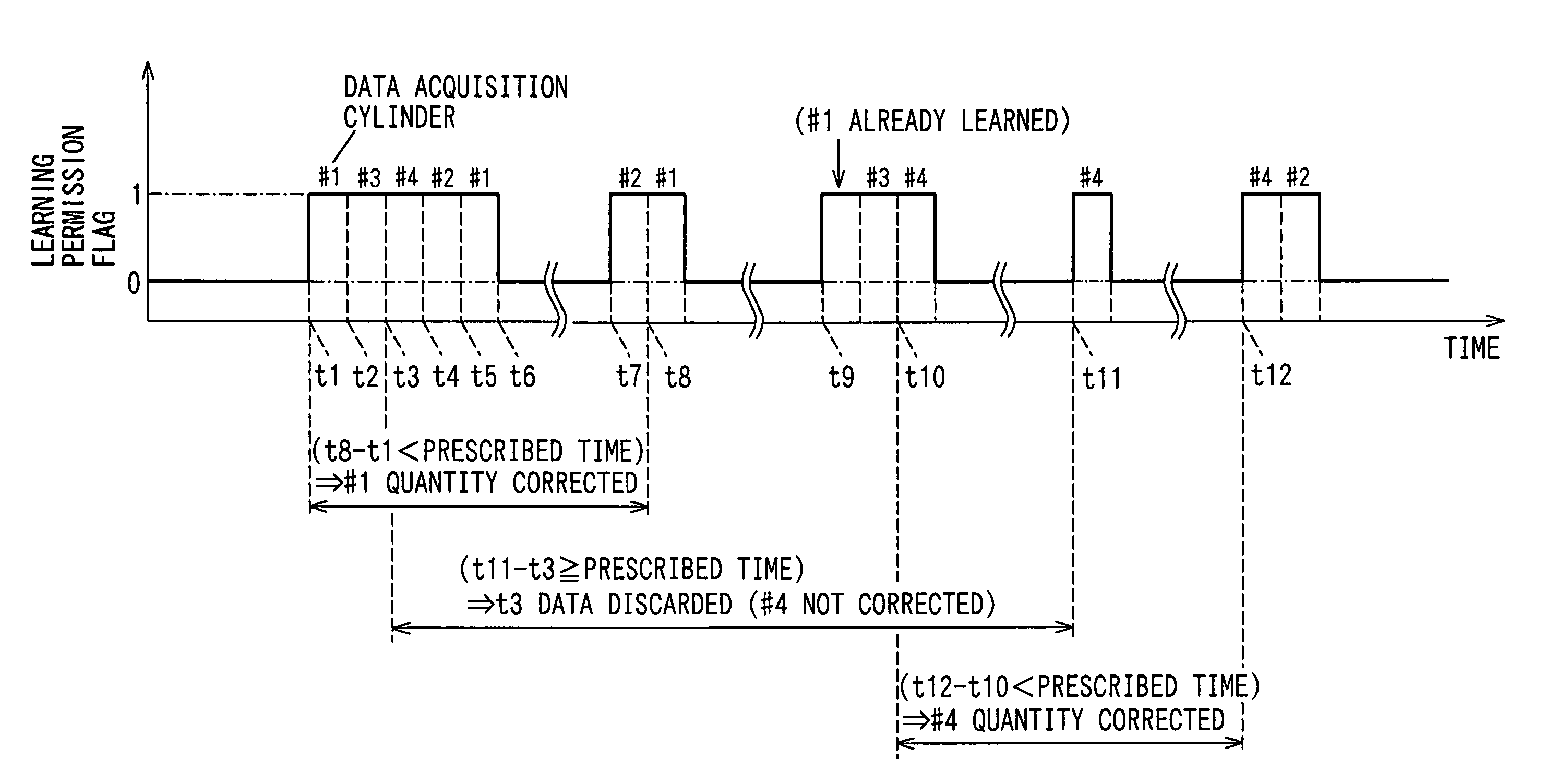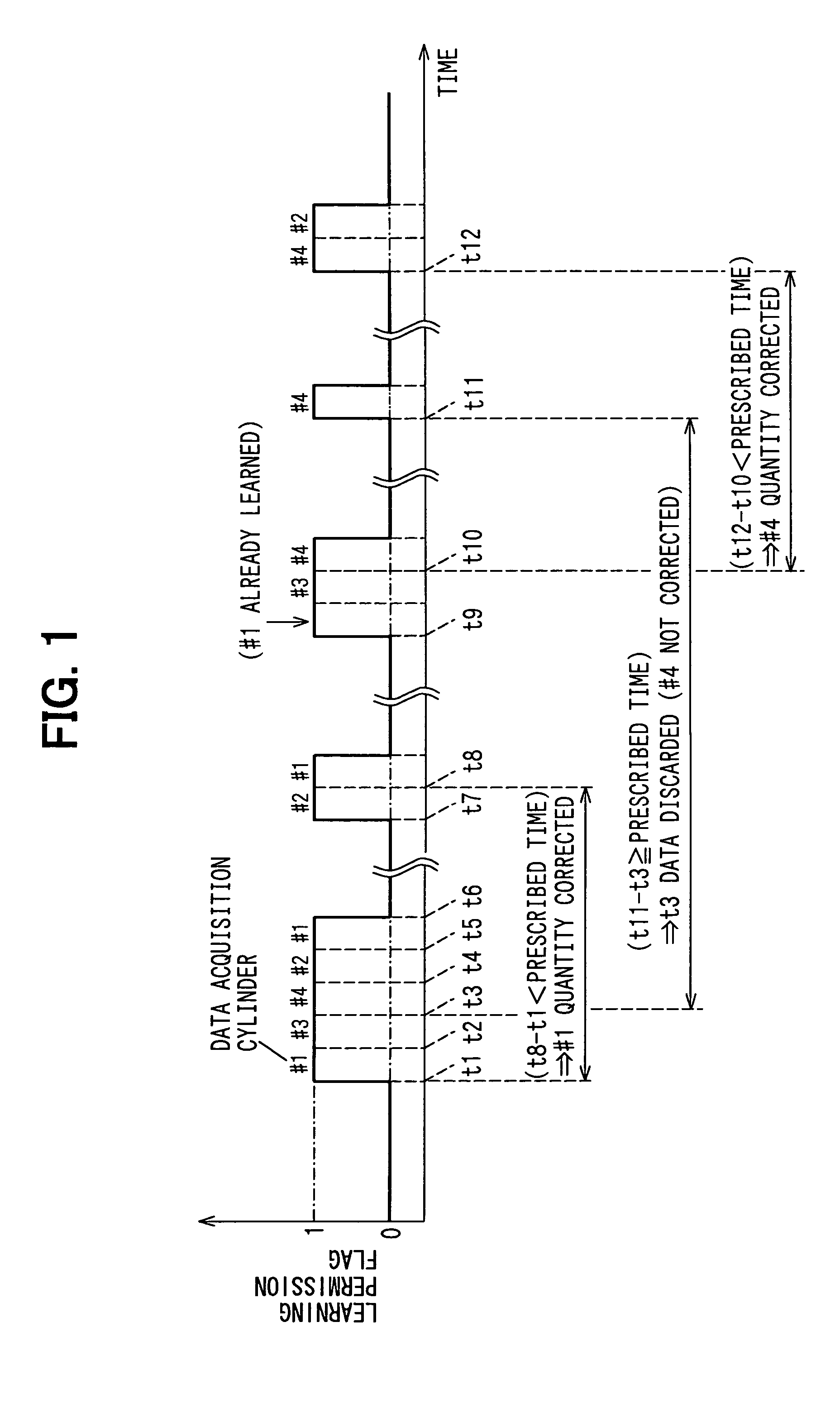Injection quantity controller for an internal combustion engine
a technology of injection quantity controller and internal combustion engine, which is applied in the direction of electrical control, process and machine control, instruments, etc., can solve the problems of reducing learning accuracy, erroneous learning, and old data may not accurately reflect, so as to improve learning accuracy
- Summary
- Abstract
- Description
- Claims
- Application Information
AI Technical Summary
Benefits of technology
Problems solved by technology
Method used
Image
Examples
first embodiment
[0036]FIG. 4 depicts a fuel injection system for a diesel engine configured in accordance with the principles of the present invention. The diesel engine includes a four-cylinder diesel engine (hereinafter referred to as an engine 1) having a fuel injection device.
[0037]The fuel injection device includes a common rail 2, a fuel pump 4, an injector 5, and an electronic control unit 6. The common rail 2 stores high-pressure fuel. The fuel pump 4 pressurizes fuel pumped from a fuel tank 3 and supplies it to the common rail 2. The injector 5 injects high-pressure fuel supplied from the common rail 2 to a cylinder (combustion chamber 1a) of the engine 1. The electronic control unit 6, hereinafter referred to as the ECU 6, controls the system.
[0038]The common rail 2 accumulates high-pressure fuel supplied by the fuel pump 4 to a target rail pressure that is set by the ECU 6. The common rail 2 includes a pressure sensor 7 and a pressure limiter 8. The pressure sensor 7 detects a fuel press...
second embodiment
[0084]FIG. 7 provides a second embodiment for checking the accumulated data in accordance with Step 170 of FIG. 5.
[0085]The checking process of the second embodiment is different from the first embodiment in that the ECU 6 returns to Step 171 after executing Step 175. Furthermore, the determination made by the ECU 6 in Step 171 is slightly different. Processing steps 172 to 174 are the same.
[0086]That is, the first embodiment, the ECU 6 checks the data when the number of pieces of accumulated data N(i) reaches the prescribed count N (Step 171: YES). However, in the second embodiment, the ECU 6 checks the data before the number of pieces N(i) reaches the prescribed count N and discards all data outside the prescribed time. Specifically, at step 171, the ECU 6 proceeds to calculating the time difference Δt when N(i) is greater than or equal to 2.
third embodiment
[0087]In the first embodiment, the ECU 6 does not correct the command injection quantity until a prescribed number N of pieces of data are acquired within the prescribed time. In a third embodiment, however, if the number of pieces of accumulated data is not greater than or equal to the prescribed count when the prescribed time lapses, the ECU 6 corrects the command injection quantity using the available data. Therefore, in FIG. 5, described above, Step 180 is eliminated in the third embodiment.
[0088]However, like the first embodiment, the ECU 6 of the third embodiment corrects the command quantity using only data acquired within the prescribed time. Any old data, which was acquired before the prescribed time, is discarded. Consequently, learning accuracy is enhanced.
[0089]It should be understood that in the third embodiment, the prescribed number of pieces of data to be accumulated within the prescribed time is not specified. Therefore, the ECU 6 corrects the command injection quan...
PUM
 Login to View More
Login to View More Abstract
Description
Claims
Application Information
 Login to View More
Login to View More - R&D
- Intellectual Property
- Life Sciences
- Materials
- Tech Scout
- Unparalleled Data Quality
- Higher Quality Content
- 60% Fewer Hallucinations
Browse by: Latest US Patents, China's latest patents, Technical Efficacy Thesaurus, Application Domain, Technology Topic, Popular Technical Reports.
© 2025 PatSnap. All rights reserved.Legal|Privacy policy|Modern Slavery Act Transparency Statement|Sitemap|About US| Contact US: help@patsnap.com



